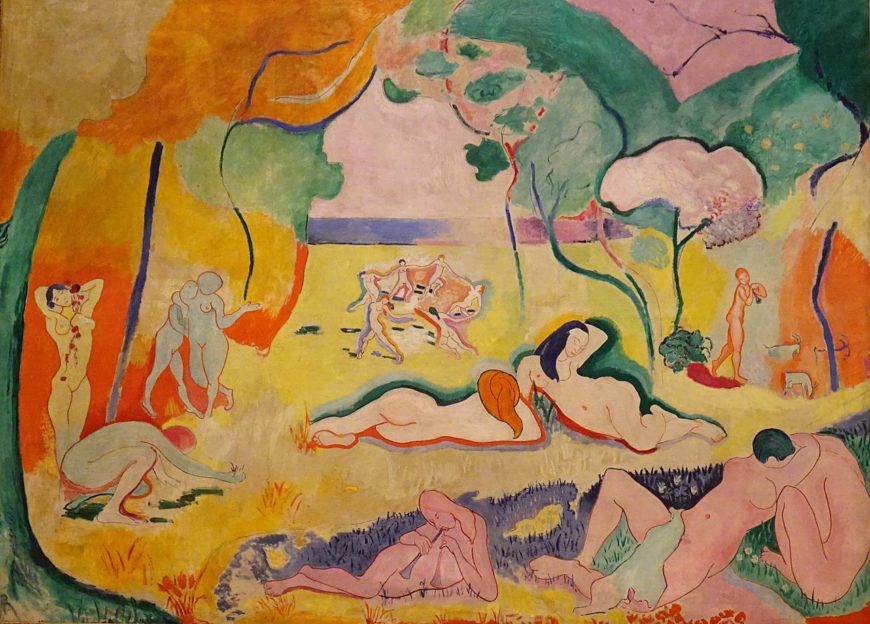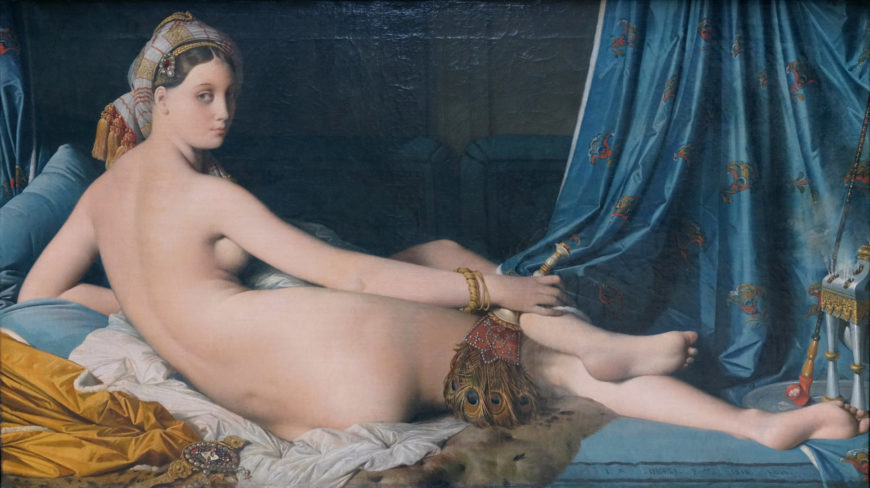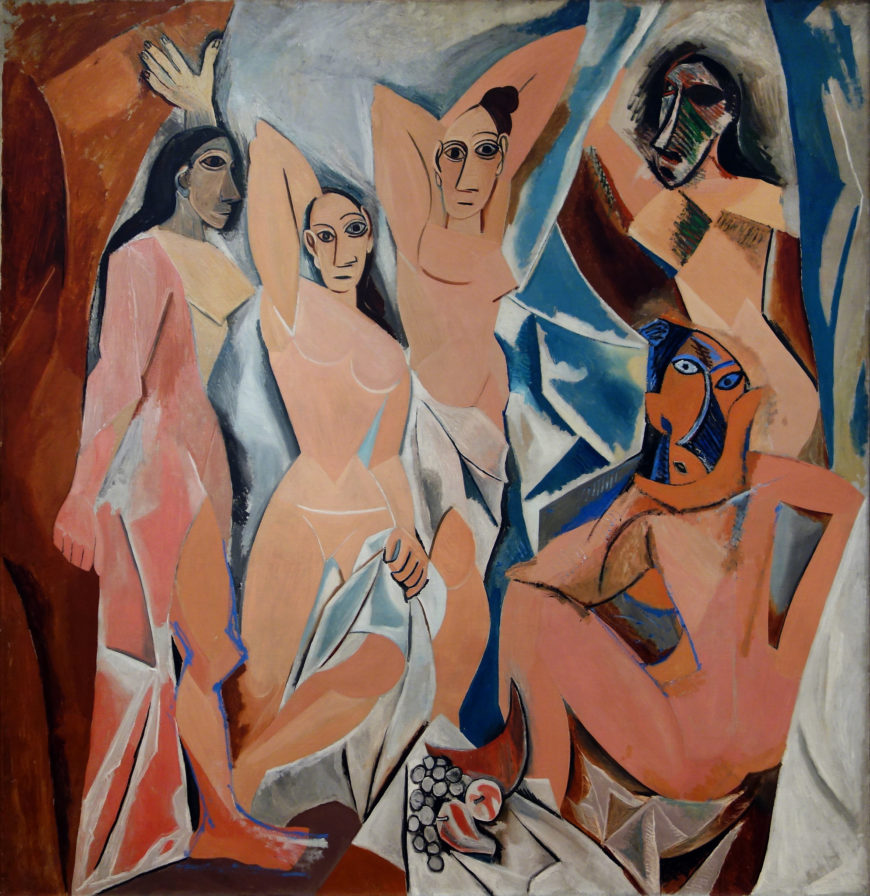Joy Of Life Matisse Meaning

Henri Matisse, Bonheur de Vivre, 1906, oil on canvas, 175 x 241 cm (The Barnes Foundation, Philadelphia, photograph: Regan Vercruysse, CC BY-NC-ND 2.0)
The Joy of Life
In 1906, Henri Matisse finished what is often considered his greatest Fauve painting, the Bonheur de Vivre, or the "Joy of Life." Information technology is a large-scale painting depicting an Arcadian landscape filled with brilliantly colored forest, meadow, sea, and heaven and populated by nude figures both at residue and in motion. As with the before Fauve canvases, colour is responsive only to emotional expression and the formal needs of the canvass, not the realities of nature. The references are many, only in form and date, Bonheur de Vivre is closest to Cézanne'southward last great image of bathers.

Paul Cézanne, The Big Bathers, 1906, oil on sail, 82 7⁄8 × 98 3⁄4″ (Philadelphia Museum of Art, photograph: DcoetzeeBot, public domain)
Matisse and his sources
Like Cézanne, Matisse constructs the mural so that it functions as a stage. In both works copse are planted at the sides and in the far distance, and their upper boughs are spread apart like curtains, highlighting the figures lounging beneath. And like Cézanne, Matisse unifies the figures and the landscape. Cézanne does this past stiffening and tilting his torso-like figures. In Matisse's work, the serpentine arabesques that define the contours of the women are heavily emphasized, and then reiterated in the curvilinear lines of the copse.

Jean-Auguste-Dominique Ingres, La Grande Odalisque, 1814, oil on canvas, 91 x 162 cm (Louvre, Paris; photo: Steven Zucker, CC BY-NC-SA ii.0)
Matisse creates wildly sensual figures in Bonheur de Vivre, which show how he was clearly informed past Ingres's odalisques and harem fantasies.

Titian, Bacchananal of the Andrians, 1523-26, oil on canvass, 175 x 193 (Museo del Prado, Madrid)
Additionally, Matisse references Titian. For like Titian'southward Bacchanalia of the Andrians, the scene depicted in Bonheur de Vivre is an expression of pure pleasure. Here is a identify full of life and dear and gratis from want or fear. Instead of a gimmicky scene in a park, on the banks of the Seine, or other recognizable places in nature, Matisse has returned to mythic paradise.
Radicalism, or how to colour exterior the lines
But do not be misled past his interest in myth—Matisse is not joining in with Bouguereau or any other Salon artist. This is the paradigm of Fauvism, a radical new arroyo that contain purely expressive, bright, clear colors and wildly sensual forms. Matisse's painting south perhaps the get-go canvas to clearly understand Cézanne's great formal challenge, and to actually farther the elder master's ideas. In fact, despite its languid poses, Bonheur de Vivre was regarded as the most radical painting of its twenty-four hours. Because of this, Matisse became known, briefly, every bit the most daring painter in Paris.

Henri Matisse, item, Bonheur de Vivre (Joy of Life), 1905–06, oil on canvas, 176.5 ten 240.vii cm (The Barnes Foundation, Philadelphia)
So what was daring about this canvas? Here is one key issue: unlike the paintings past Cézanne, Ingres, or Titian, Matisse's work does non draw forms that recede in the groundwork and diminish in scale. If you study the figures in the foreground and the middle ground of Bonheur de Vivre, you will find that their calibration is desperately skewed. The shift of scale between the histrion of the double flute (lesser middle) and the smooching couple (bottom right) is plausible, if we take the musician to exist a child, merely what of the giants just behind them? Compared to the figures standing in the wings, who are plainly mature women (middle ground left), these centre women are of enormous proportion. They are merely too big to brand sense of inside the traditional conventions of Western painting.
Perspective, patronage and Picasso
So why has Matisse done this? How could these shifts of scale make sense? Have we seen anything like this before? Well, in a sense we have. Cézanne's painting ruptured forms in gild to accurately explore vision as experienced through time and space—in other words, forms wait different depending on where we are in relation to them.
In fact, this exploration of vision through space is the key to understanding Matisse's piece of work. By incorporating shifting perspectives, he brought this thought to a grand calibration. Put simply, Matisse's shifting scale is actually the upshot of our changing position vis-à-vis the figures. Equally a result of his experimentation with perspective, the viewer relates differently to the painting and is required to "enter" the scene. It is only from the varied perspectives within this mural that the abrupt ruptures of scale make sense.

Henri Matisse, detail, Bonheur de Vivre (Joy of Life), 1905–06, oil on canvas, 176.5 x 240.7 cm (The Barnes Foundation, Philadelphia)
The painting was purchased by a wealthy departer American writer-poet named Gertrude Stein and her blood brother, Leo Stein, who shared a home filled with modernistic art at 27 Rue de Fleurus, in Paris. This was as well the location for Gertrude Stein's weekly salon. Here, Matisse, Apollinaire, the immature and largely unknown Picasso and other members of the avant-garde came together to exchange ideas.
Stein was able to concenter such a crowd not simply because of her literary skills only because she frequently provided financial support to these nearly destitute artists. In fact, the Steins bought Matisse'south Bonheur de Vivre soon after its completion and hung information technology in their dining room for all to see. One person who saw it in that location was Picasso. Past all accounts the painting'southward fame was too much for the terribly competitive immature Spaniard. He determined to out do Matisse, and he did with his 1907 canvas, Demoiselles d'Avignon (MoMA).

Pablo Picasso, Les Demoiselles d'Avignon, 1907, oil on canvas, viii′ x vii′ 8″ (243.9 x 233.7 cm) (Museum of Modern Art, New York, photo: Steven Zucker, CC BY-NC-SA ii.0)
Picasso turned Matisse's sensuality into tearing pornography. Matisse in plough responds to the challenge of what was then called "primitivism" with his ain make of aggression in his Blue Nude.

Henri Matisse, The Blueish Nude (Gift de Biskra), 1907, oil on sail, 92.ane x 140.3 cm (Baltimore Museum of Art)
Additional resources:
This painting at The Barnes Foundation
The Fauves from the National Gallery of Art Online Bout
Matisse at MoMA
Cite this page every bit: Dr. Beth Harris and Dr. Steven Zucker, "Henri Matisse, Bonheur de Vivre," in Smarthistory, Baronial 9, 2015, accessed October 21, 2022, https://smarthistory.org/matisse-bonheur-de-vivre/.
Joy Of Life Matisse Meaning,
Source: https://smarthistory.org/matisse-bonheur-de-vivre/
Posted by: pipesglikeltas.blogspot.com


0 Response to "Joy Of Life Matisse Meaning"
Post a Comment